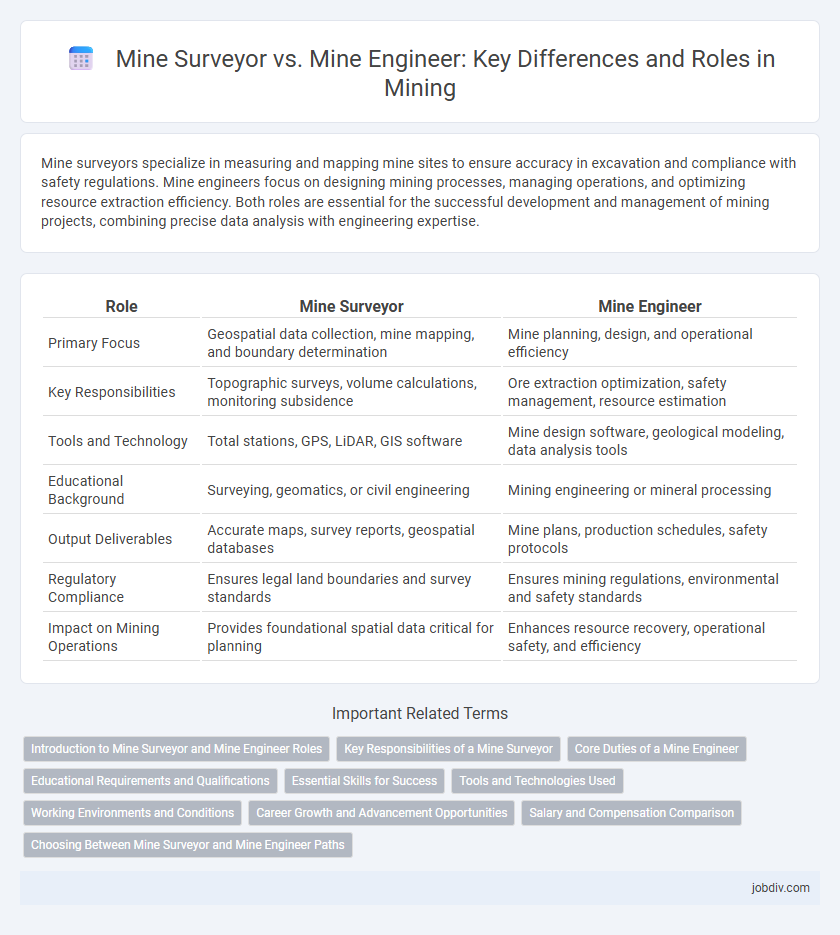Mine surveyors specialize in measuring and mapping mine sites to ensure accuracy in excavation and compliance with safety regulations. Mine engineers focus on designing mining processes, managing operations, and optimizing resource extraction efficiency. Both roles are essential for the successful development and management of mining projects, combining precise data analysis with engineering expertise.
Table of Comparison
| Role | Mine Surveyor | Mine Engineer |
|---|---|---|
| Primary Focus | Geospatial data collection, mine mapping, and boundary determination | Mine planning, design, and operational efficiency |
| Key Responsibilities | Topographic surveys, volume calculations, monitoring subsidence | Ore extraction optimization, safety management, resource estimation |
| Tools and Technology | Total stations, GPS, LiDAR, GIS software | Mine design software, geological modeling, data analysis tools |
| Educational Background | Surveying, geomatics, or civil engineering | Mining engineering or mineral processing |
| Output Deliverables | Accurate maps, survey reports, geospatial databases | Mine plans, production schedules, safety protocols |
| Regulatory Compliance | Ensures legal land boundaries and survey standards | Ensures mining regulations, environmental and safety standards |
| Impact on Mining Operations | Provides foundational spatial data critical for planning | Enhances resource recovery, operational safety, and efficiency |
Introduction to Mine Surveyor and Mine Engineer Roles
Mine surveyors specialize in measuring and mapping underground and surface mine layouts using advanced geospatial technology to ensure accurate excavation and compliance with safety regulations. Mine engineers focus on the design, planning, and optimization of mining operations, including resource evaluation, equipment selection, and environmental management. Both roles are essential for efficient mine development, safety assurance, and maximizing resource extraction.
Key Responsibilities of a Mine Surveyor
A Mine Surveyor specializes in measuring and mapping underground and surface mine sites to ensure accurate spatial data for mine planning and development. Key responsibilities include conducting topographic surveys, monitoring mine boundaries, calculating ore volumes, and providing precise data on mine layouts to support safe and efficient extraction processes. Their work ensures compliance with legal regulations and helps optimize resource management within mining operations.
Core Duties of a Mine Engineer
A Mine Engineer primarily focuses on planning, designing, and overseeing mining operations to ensure efficient extraction of minerals while adhering to safety and environmental regulations. Their core duties include evaluating mine feasibility, optimizing production processes, managing resources, and implementing innovative mining technologies. Unlike Mine Surveyors who specialize in mapping and measuring mine sites, Mine Engineers drive the strategic and technical aspects of mining projects.
Educational Requirements and Qualifications
Mine surveyors typically require a degree in geomatics, mining engineering, or surveying, along with certifications like the Registered Professional Surveyor (RPS) credential. Mine engineers generally hold degrees in mining engineering or related fields and must acquire professional engineering licenses such as the Professional Engineer (PE) certification. Both roles demand strong technical knowledge, but mine engineers focus more on project design and safety, while mine surveyors specialize in precise measurements and spatial data management.
Essential Skills for Success
Mine surveyors require advanced expertise in geospatial measurement, precision mapping, and data analysis to ensure accurate mine layout and safety compliance. Mine engineers must possess strong technical knowledge in mining methods, resource estimation, and project management to optimize excavation and ore recovery processes. Both roles demand proficiency in software tools, critical thinking, and effective communication for operational efficiency and risk mitigation.
Tools and Technologies Used
Mine Surveyors primarily rely on advanced geographic information systems (GIS), total stations, laser scanning, and unmanned aerial vehicles (UAVs) to create precise spatial data and topographic maps essential for mine planning. Mine Engineers utilize specialized software such as mine design programs (Surpac, Vulcan), ventilation simulation tools, and automated machinery control systems to optimize mining operations and ensure safety. Both professionals integrate technologies like GPS and 3D modeling, but their focus differs: surveyors emphasize accurate measurement and mapping, while engineers focus on applying this data to design and operational efficiency.
Working Environments and Conditions
Mine surveyors primarily work outdoors in various terrains, often exposed to harsh weather and challenging physical conditions while conducting measurements and mapping underground and surface mine areas. Mine engineers typically operate both in office environments for planning and design and on-site for overseeing mining operations, managing safety, and coordinating equipment usage under variable conditions. Both roles require adaptation to fluctuating temperatures, confined spaces, and strict safety protocols inherent to mining environments.
Career Growth and Advancement Opportunities
Mine surveyors specialize in mapping and measuring mining sites, ensuring accurate spatial data essential for operational planning, with career growth often leading to senior surveyor or geospatial data management roles. Mine engineers focus on the design, development, and optimization of mining processes, offering advancement opportunities toward project management, operations leadership, or technical consultancy. Both professions require continuous skill development, but mine engineers typically experience broader career mobility due to their involvement in operational decision-making and strategic planning.
Salary and Compensation Comparison
Mine engineers typically earn higher salaries than mine surveyors due to their broader responsibilities, with average annual compensation for mine engineers ranging from $75,000 to $120,000. Mine surveyors usually have a salary range between $60,000 and $95,000, reflecting their specialized focus on mapping and measurement tasks within mining operations. Benefits and bonuses for mine engineers often surpass those for mine surveyors, driven by the engineers' crucial role in project planning and safety management.
Choosing Between Mine Surveyor and Mine Engineer Paths
Choosing between a mine surveyor and a mine engineer depends on your skills and career goals within the mining industry. Mine surveyors specialize in mapping and underground measurements using advanced surveying technology, ensuring accurate mine layouts and safety compliance. Mine engineers focus on planning, designing, and optimizing mining operations with a strong foundation in geology, extraction methods, and resource management.
Mine Surveyor vs Mine Engineer Infographic

 jobdiv.com
jobdiv.com